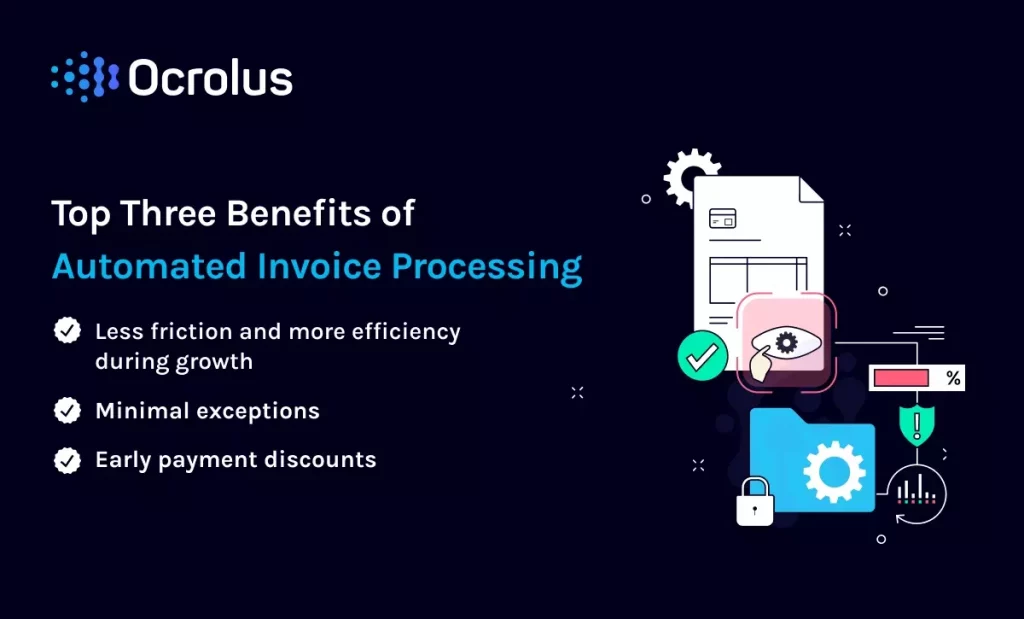Top Three Benefits of Automated Invoice Processing

Every company has an Accounts Payable (AP) function. Whether you’re a sole proprietor with a makeshift approach, or a corporation with shared services operations, every organization has some kind of procedure for invoice processing. And for as long as there have been invoices, processing them has been time-consuming and expensive.
When it comes to measuring the performance of an AP department, the two biggest questions are:
- How much time does it take to process an invoice?
- What are the costs?
The answers are often higher than you might think. It costs companies $5.50 to process an invoice, on average, with over 40% of invoices being paid after they are due!
Driving efficiency in Accounts Payable is clearly an opportunity for cost savings. However digital transformation in this space has been tough, as invoicing operations and technology have multiple points of friction and inherent complexity. For example, digitization, reconciliation, PO matching, vendor lookups, etc.
The biggest challenge in Accounts Payable is that it has always been a document-intensive function. Larger organizations receive immense quantities of invoices from different vendors, each of which usually has its own format and nuances. While Electronic Data Interchange (EDI) is an efficient technology for reducing the burden of invoice documentation, EDI has proven difficult to implement. The reality is that 70% of invoices are still received in the form of documents, whether they are furnished by the vendor over email, or sent as paper via snail mail.
Processing invoice documents is expensive, and proper due diligence is the fundamental culprit: before a business pays a bill, it better make sure that the bill is legitimate and the information is correct. As such, each invoice must have data accurately extracted and structured into a format that can be processed by an accounting or ERP system. This data extraction from invoices is a highly manual task, and many larger organizations employ clerks whose main job is to perform data entry from invoices.
Optical Character Recognition (OCR) for invoice processing, which converts images to text, has been used for decades now in Accounts Payable. However, legacy capture solutions for OCR and data extraction have been slow and expensive to deploy, and often yield inaccurate results.
In the early days of AP automation (around the turn of the millennium,) legacy OCR vendors replaced manual systems with integrated software, helping some of the largest organizations reduce manual data entry delays, expense and errors. Not surprisingly, manual labor in document processing was a big issue. Promising to reduce manual data entry by 40-50% was a reasonable value proposition, even if it meant several months of implementation efforts and scores of revisions to the AP process.
Core OCR technology has advanced little in the past two decades. Despite claims of machine learning and AI, invoice extraction software is still expensive and difficult to implement, while delivering only marginal productivity gains.
Many businesses are rightfully frustrated by legacy OCR solutions, and abandon them completely, resorting entirely to manual labor. Even organizations that utilize legacy capture solutions can only automate about half the work, spending valuable man-hours compensating for the limitations of complicated, ineffective invoice processing technology.
When we talk to Accounts Payable managers, they often say, “we already tried using OCR and it didn’t work.” We encourage companies to challenge their preexisting conceptions of document capture and consider innovative new technology that provides many advantages for your business.
Machine learning and specialized BPM systems have great synergy and are being combined in clever new ways. While old legacy systems remain ineffective, the combination of modern machine learning and human-in-the-loop processing can deliver turnkey automation with 99% accuracy.
Here are the top three benefits of modern automated invoice processing:
-
1. Less friction and more efficiency during growth
Organizations are empowered to remove friction from the process, especially as they grow or add new vendors. An intelligent automated system enables companies to repurpose head count and improve human resource management. One clerk might process just 100 invoices per day in a manual process, or maybe 200 with the aid of legacy OCR. With human-in-the-loop automation technology, a single clerk can process upwards of 500 invoices per day with unprecedented accuracy, freeing up the rest of staff to focus on more valuable and cerebral work.
-
2. Minimal exceptions
It costs a lot to process invoices on the first pass, and exception handling is even more expensive. In fact, research shows that it is at least 5x more expensive to process an invoice through an exception flow than a standard procedure. While automation of data entry is the biggest lift from invoice automation, a leaner and more precise exceptions flow yields additional benefits. Accurate classification and extraction drives more efficient lines of communication, both internally and with vendors. With an intelligent automated system, organizations can minimize exceptions and maximize throughput.
-
3. Early payment discounts
Many vendors will provide a discount if an invoice is paid in 10-15 days. With traditional workflows, organizations struggle to process invoices in a timely manner, and thus will miss out on prepayment incentives. An intelligent and automated system enables organizations to stay ahead of deadlines in order to capitalize on discounts and promote better supplier relations.
Time to revisit Accounts Payable automation solutions
After decades of being laden with manual processes and obtuse software, Accounts Payable is poised to reap the benefits of integrated document and data automation. By employing advanced yet intuitive technology, businesses can streamline the core of their invoicing operation: document processing. The result is leaner, faster organizations that optimize their own human capital and develop mutual efficiencies with vendor partners.
See how intelligent automated invoice processing can be advantageous for your business by booking a demo of Ocrolus today.
####
John Guerci is Director of Strategy at Ocrolus, a fintech infrastructure company based in New York




